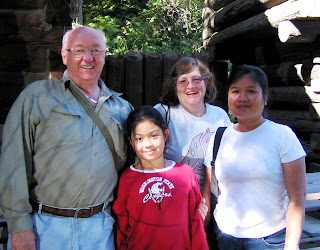



Construction continues apace today as the crew puts up the roof deck ... we're going to be indoors pretty soon!
Yesterday I wrote of school kids disembarking at the Museum. We get about 5,000 participants in our admission-free School Tour Program each year and another 2,500 who arrive with parents, grandparents, et al. We conder the Museum to be an adjunct to what goes on in classrooms all across the region, including public, private, and home schools. With some serious generosity from Boise, Inc.'s Wallula Mill, Blue Mountain Community Foundation, J.L. Stubblefield Trust, Bonnie Braden Trust, and the Pacific Power Foundation, we can offer tours of the Museum to schools without cost to them beyond bus drivers and gas. Not bad for your neighborhood non-profit heritage Museum!
Heritage is a shared experience providing a foundation on which to build for the future. By connecting children with their heritage, great things happen. Children gain a sense of place and belonging in their community and in the process their self-esteem grows. Heritage education helps children become fully integrated, productive members of society. Fort Walla Walla Museum supports the educational process and inspires children to learn more about their heritage.
Learning takes place on many levels in the life of a child. Schools perform exceptional work in many areas, but the difficulty of making history come alive for students can be both costly and logistically daunting. A school trip to Fort Walla Walla Museum can be particularly useful in supporting classroom-based assessments (CBA). Children can see and touch aspects of the past that books and lectures cannot address. Utilizing the Museum’s free Teacher’s Guide, teachers may prepare students for a visit and find activities in multiple disciplines for follow-up learning.
Through ongoing surveys of visiting students, the Museum has learned that 86% have never visited a museum before. Further, 82% want to return with their families. Beginning with the new Entrance, a ‘Kid’s Museum’ will be interwoven within the larger Museum. Children who can connect with the region’s past will feel a sense of belonging to their communities, develop healthy self-esteem, and become involved in something greater than themselves. Engaging, interactive, fun, and seamlessly educational hands-on stations children identify by spotting “Maury the Mule,” a friendly, cartoon graphic clad in overalls, red 'long-handles,' and straw hat signaling where children can get involved with the past.
Today's photos show the Museum's 'Maury the Mule' icon, the roof deck being built over the Grand Hall, and our wonderful Docent Vi Jones (left) and teacher Tamar Lundsen with students from Othello's Hiawatha School.




































